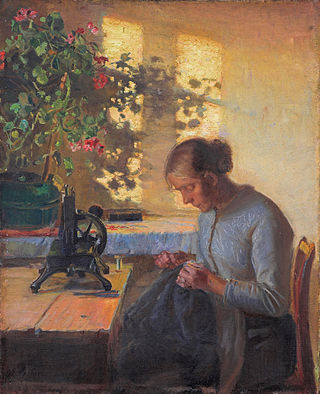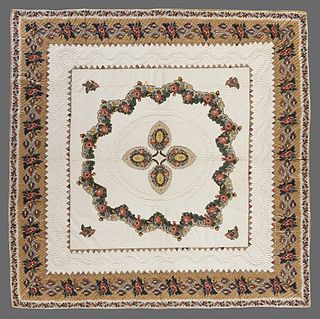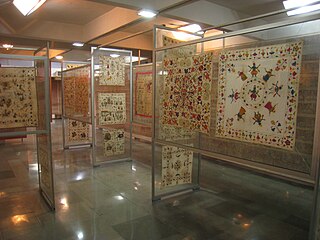
Patchwork or "pieced work" is a form of needlework that involves sewing together pieces of fabric into a larger design. The larger design is usually based on repeating patterns built up with different fabric shapes. These shapes are carefully measured and cut, basic geometric shapes making them easy to piece together.

Assisi embroidery is a form of counted-thread embroidery based on an ancient Italian needlework tradition in which the background is filled with embroidery stitches and the main motifs are outlined but not stitched. The name is derived from the Italian town of Assisi where the modern form of the craft originated.

Berlin wool work is a style of embroidery similar to today's needlepoint that was particularly popular in Europe and America from 1804 to 1875. It is typically executed with wool yarn on canvas, worked in a single stitch such as cross stitch or tent stitch, although Beeton's book of Needlework (1870) describes 15 different stitches for use in Berlin work. It was traditionally stitched in many colours and hues, producing intricate three-dimensional looks by careful shading. Silk or beads were frequently used as highlights. The design of such embroidery was made possible by the great progress made in dyeing, initially with new mordants and chemical dyes, followed in 1856, especially by the discovery of aniline dyes, which produced bright colors.

A quilt is a multi-layered textile, traditionally composed of two or more layers of fabric or fiber. Commonly three layers are used with a filler material. These layers traditionally include a woven cloth top, a layer of batting or wadding, and a woven back combined using the techniques of quilting. This is the process of sewing on the face of the fabric, and not just the edges, to combine the three layers together to reinforce the material. Stitching patterns can be a decorative element. A single piece of fabric can be used for the top of a quilt, but in many cases the top is created from smaller fabric pieces joined, or patchwork. The pattern and color of these pieces creates the design.

Crewel embroidery, or crewelwork, is a type of surface embroidery using wool. A wide variety of different embroidery stitches are used to follow a design outline applied to the fabric. The technique is at least a thousand years old.

Sewing is the craft of fastening or attaching objects using stitches made with a sewing needle and thread. Sewing is one of the oldest of the textile arts, arising in the Paleolithic era. Before the invention of spinning yarn or weaving fabric, archaeologists believe Stone Age people across Europe and Asia sewed fur and leather clothing using bone, antler or ivory sewing-needles and "thread" made of various animal body parts including sinew, catgut, and veins.

Broderie perse is a style of appliqué which uses printed motifs from one fabric to create a design on a background fabric. It was popular in the late 18th century and early 19th centuries. The technique could be considered an early form of puzzle piecing.

Korean embroidery techniques and artifacts have a long history, but there is the most evidence from the Joseon Dynasty, after the 14th century in Korea. This article talks about the history, styles, preservation, artists, and examples of screens, costumes, and domestic wares of this exacting and beautiful art form.

Armenian needlelace is a pure form of needle lace made using only a needle, thread and pair of scissors.

Phulkari refers to the folk embroidery of the Punjab and Gulkari of Sindh in South Asia. Although Phulkari means floral work, the designs include not only flowers but also cover motifs and geometrical shapes. The main characteristics of Phulkari embroidery are use of darn stitch on the wrong side of coarse cotton cloth with coloured silken thread. Punjabi women create innumerable alluring and interesting designs and patterns by their skilful manipulation of the darn stitch. According to Kehal (2009), a cloth where only a few flowers are embroidered is called a Phulkari. The other types are distinct varieties. The traditional varieties of Phulkaris are large items of cloth and include Chope, Tilpatr, Neelak and Bagh. Sometimes, the Bagh is given separate categorization of its own as on other varieties of a Phulkari, parts of the cloth is visible, whereas in a Bagh, the embroidery covers the entire garment so that the base cloth is not visible. Further, in contemporary modern designs, simple and sparsely embroidered dupattas, odhinis, and shawls, made for everyday use, are referred to as phulkaris, whereas clothing items that cover the entire body, made for special and ceremonial occasions such as weddings are called baghs. The Phulkari continues to be an integral part of Punjabi weddings to the present day.

Embroidery in India includes dozens of embroidery styles that vary by region and clothing styles. Designs in Indian embroidery are formed on the basis of the texture and the design of the fabric and the stitch. The dot and the alternate dot, the circle, the square, the triangle, and permutations and combinations of these constitute the design.

Ukrainian embroidery occupies an important place among the various branches of Ukrainian decorative arts. Embroidery has a rich history in Ukraine, and has long appeared in Ukrainian folk dress as well as played a part in traditional Ukrainian weddings and other celebrations. Appearing all across the country, Ukrainian embroidery varies depending on the region of origin. From Poltava, Kyiv, and Chernihiv in the east, to Volyn and Polissia in the northwest, to Bukovina, and the Hutsul area in the southwest, the designs have a long history which defines its ornamental motifs and compositions, as well as its favorite choice of colors and types of stitches.

Palestinian traditional clothing are the types of clothing historically and sometimes still presently worn by Palestinians. Foreign travelers to Palestine in the 19th and early 20th centuries often commented on the rich variety of the costumes worn, particularly by the fellaheen or village women. Many of the handcrafted garments were richly embroidered and the creation and maintenance of these items played a significant role in the lives of the region's women.

Nakshi kantha, a type of embroidered quilt, is a centuries-old Bengali art tradition of the Bengal region, notable in Bangladesh and Indian states of West Bengal, Tripura and part of Assam. The basic material used is thread and old cloth. Nakshi kanthas are made throughout Bangladesh, but the greater Mymensingh, Jamalpur, Bogra, Rajshahi, Faridpur and Jessore, Chittagong areas are most famous for this craft.

English embroidery includes embroidery worked in England or by English people abroad from Anglo-Saxon times to the present day. The oldest surviving English embroideries include items from the early 10th century preserved in Durham Cathedral and the 11th century Bayeux Tapestry, if it was worked in England. The professional workshops of Medieval England created rich embroidery in metal thread and silk for ecclesiastical and secular uses. This style was called Opus Anglicanum or "English work", and was famous throughout Europe.
The Hat and Fragrance Textile Gallery is an exhibit space at Shelburne Museum in Shelburne, Vermont which houses quilts, hatboxes, and various other textiles. The name "Hat and Fragrance" refers both to Electra Havemeyer Webb's collection of hatboxes and to the fragrant, herbal sachets used to preserve textiles. In 1954, Shelburne Museum was the first museum to exhibit quilts as works of art; prior to this exhibition quilts were only shown as accessories in historic houses.

Embroidery was an important art in the Islamic world from the beginning of Islam until the Industrial Revolution disrupted traditional ways of life.
The Sujani embroidery work of Bihar, is a textile expressive art product, given protection under the GI registration act. It is usually a quilt or bed spread, which was earlier made of old clothes, but is now generally made of easily available fabric with embroidery done with the most simple stitches with motifs narrating stories. It is exclusively made by women in 15 villages of Bhusra in the Gaighat block of Muzaffarpur and a few villages of Madhubani in the Indian state of Bihar.

The term Hedebo embroidery covers several forms of white embroidery which originated in the Hedebo (heathland) region of Zealand, Denmark, in the 1760s. The varied techniques which evolved over the next hundred years in the farming community were subsequently developed by the middle classes until around 1820. They were applied to articles of clothing such as collars and cuffs but were also used to decorate bed linen.

Colcha embroidery from the southwest United States is a form of surface embroidery that uses wool threads on cotton or linen fabric. During the Spanish Colonial period, the word colcha referred to a densely embroidered wool coverlet. In time, the word also came to refer to the embroidery stitch that was used for these coverlets, and then began to be used on other surfaces. The colcha stitch is self-couched, with threads applied at a 45-degree angle to tie down the stitch. Originally, the wool threads were dyed naturally, using plants or insects, such as cochineal. Both materials used and design motifs have varied over time.


















